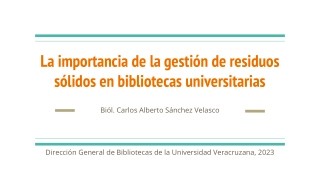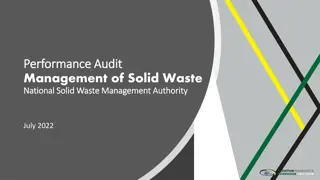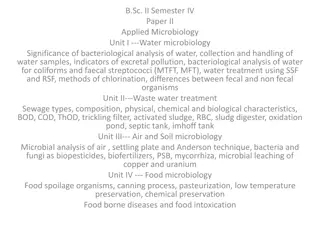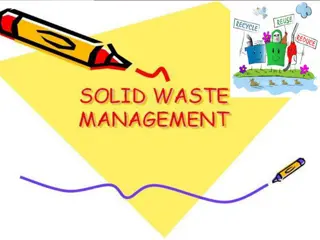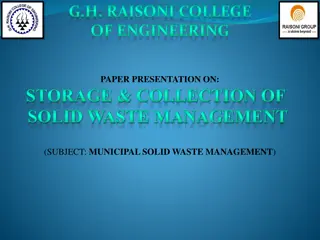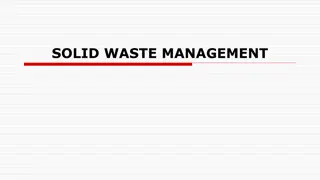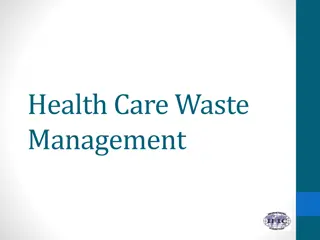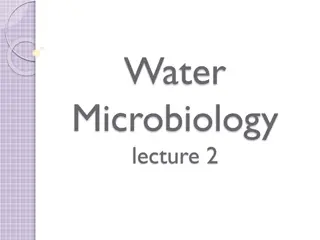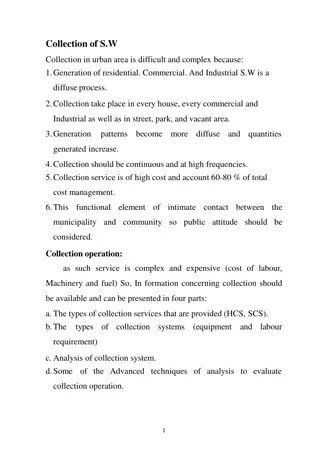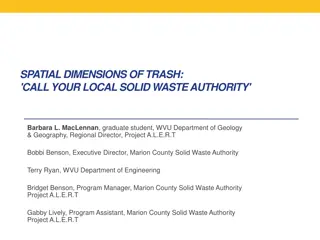Understanding Waste Water Microbiology and Solid Waste Management
Waste water microbiology involves the analysis of liquid waste in terms of its composition, strength (BOD and COD), and treatment processes. It covers the sources and types of solid waste, along with methods of disposal like composting and sanitary landfilling. The chemical characteristics of waste water, including domestic and industrial components, are critical for efficient treatment. Proper waste water and solid waste management are essential for environmental sustainability.
Download Presentation

Please find below an Image/Link to download the presentation.
The content on the website is provided AS IS for your information and personal use only. It may not be sold, licensed, or shared on other websites without obtaining consent from the author. Download presentation by click this link. If you encounter any issues during the download, it is possible that the publisher has removed the file from their server.
E N D
Presentation Transcript
UNIT- 4: Waste Water Microbiology Liquid waste management: Composition and strength of sewage (BOD and COD), Primary, Secondary (oxidation ponds, trickling filter, activated sludge process and septic tank) and tertiary sewage treatment - Pelczar 5th edition: Page no.:603-614 Solid Waste management: Sources and types of solid waste, Methods of solid waste disposal (composting and sanitary landfill) - Pelczar 5th edition: Page no.:603-614 Sanitary landfill : Principle of Microbiology by R.M Atlas second edition: Page no: 788-789(sanitary landfill)
Liquid waste management Composition and strength of sewage (BOD and COD) Wastewater is the used water supply of a community and consists of: 1. Domestic waterborne wastes, wastewater or sewage, including human excrement and wash waters everything that goes down the drains of a home and into a sewerage system. 2. Industrial waterborne wastes such as acids, oil, greases, and animal and vegetable matter discharged by factories. 3. Ground, surface, and atmospheric waters that enter the sewerage system.
system, which carries the used water to its ultimate point of treatment and disposal. There are three kinds of sewerage systems: (1) Sanitary sewers, which carry domestic and industrial wastewater. (2) Storm sewers designed to carry off surface and storm (atmospheric) water. (3) Combined sewers which carry the wastewater (sewage) through a single system of sewers. The wastewater of a city is collected through a sewerage Chemical Characteristics of Waste water Domestic wastewater or sewage consists of approximately 99.9 percent water, 0.02 to 0.03 percent suspended solids, and other soluble organic and inorganic substances.
On a percentage basis, the amount of solids appears small; however, the tremendous volume of material handled daily by a major municipal plant (e.g., several hundred millions of gallons) contains as much as 100 tons of solids. The chemical constituents, present in low concentrations, nevertheless are extremely important and are subject to variations between communities as well as within a community, even from hour to hour. Inorganic chemicals initially present in the water supply will likewise be present in the sewage. Organic compounds are contributed through human excrement and other domestic wastes, and both organic and inorganic compounds are added by industrial wastes. For example, slaughterhouses, sugar factories, paper mills, and creameries add organic substances: mines and metal industries contribute acids and salts of metals and other inorganic wastes.
The organic compounds in sewage are classified as nitrogenous or nonnitrogenous. The principal nitrogenous compounds are urea, proteins, amines. and amino acids; the nonnitrogenous substances include carbohydrates, fats, and soaps. Modern technology may produce significant changes in sewage characteristics. The increased use of household garbage-disposal units has increased the total organic load. Some synthetic detergents displacing soaps are resistant to microbial degradation. BOD (Biological Oxygen Demand) The biochemical oxygen demand (BOD) is a measure of the amount of oxygen used in the respiratory processes of microorganisms in oxidizing the organic matter in the sewage and for the further metabolism (oxidation) of cellular components synthesized from the wastes.
One of the primary reasons for treating wastewater prior to its being returned to the water resource (e.g. stream or lake) is to reduce the drain on dissolved oxygen supply of the receiving body of the water. The magnitude of the BOD is related to the amount of organic material in the wastewater-i.e. the more oxidizable organic material, the higher the BOD. The "strength" of wastewater is expressed in terms of BOD level.
Chemical oxygen demand" (COD) BOD test takes 5 days it may be necessary to resort to the chemical oxygen demand" (COD), a chemical test which only takes a few hours to complete. The test is based on treating the sample with a known amount of boiling acidic potassium dichromate solution for 2.5 to 4 hours and then titrating the excess dichromate with ferrous sulphate or ferrous ammonium sulphate. The oxidized organic matter is taken as being proportional to the potassium dichromate utilized. Most compounds are oxidized virtually to completion in this test, including those which are not biodegradable. In circumstances where substances are toxic to microorganisms, the COD test may be the only suitable method available for assessing the degree of treatment required.
Microbial Characteristics of Waste water Since the composition of wastewater varies, it is to be expected that the type and numbers of organisms will fluctuate. Fungi, protozoa, algae, bacteria, and viruses are present. Raw sewage may contain millions of bacteria per milliliter including the coliforms, streptococci, anaerobic spore-forming bacilli, the Proteus group, and other types originating in the intestinal tract of humans. Sewage is also a potential source of pathogenic protozoa, bacteria, and viruses. The causative agents of dysentery, cholera, and typhoid fever may occur in sewage. The poliomyelitis virus, the virus of infectious hepatitis, and the coxsackie viruses are excreted in the feces of infected hosts and thus may appear in sewage. Certain bacterial viruses are readily isolated from sewage.
the course sewage digestion. In an anaerobic digester, facultative types (Enterobacter, Alcaligenes, Escherichia, Pseudomonas etc.) predominate during initial stages. This is followed by methane producers, which are strict anaerobes, e.g. Methanobacterium, Methanosarcina, and Methanococcus. Organic acids produced by the facultative bacteria are metabolized by the methane formers; the end products are methane and carbon dioxide. Large amounts of these gases are produced in anaerobic digesters. The various processes associated with treatment of wastewater bring about pronounced changes in the predominant types of organisms. These changes and their significance will be discussed later. Predominant physiological types of bacteria may shift during
WASTEWATER TREAT MENT AND DISPOSAL Wastewater treatment is necessary before wastewater can be disposed of without producing significant undesirable or even harmful effects. However, some communities and municipalities will dispose of Inadequately treated wastewater Into natural bodies of water, either because they are Indifferent to the consequences or because it is assumed that the body of water is sufficiently large and so located that dilution prevents hazards. Communities and municipalities can no longer rely on disposal of wastewater by dilution. There is an ever-increasing demand for domestic and Industrial water, necessitating more reuse of water that receive wastewaters. Disposal of Inadequately treated wastewater leads to: 1. Greater possibility for dissemination of pathogenic microorganisms. 2. Increased danger in using natural bodies of water for drinking supplies.
3. Contamination of oysters and other shellfish by the pollution, making them unsafe for human consumption. 4. Large losses in the waterfowl population chargeable to pollution of their winter feeding ground. 5. Increased danger of swimming in the water and diminished value of the water for other recreational purposes. 6. Depletion of oxygen supply of the water by unstable organic matter in sewage, killing aquatic life. 7. Creation of miscellaneous objectionable conditions such as offensive odors and accumulation of debris, which decrease property values. 8. Accumulation and dissemination of toxic chemicals that endanger ecosystems and threaten public health.
Waste water Treatment Processes Wastewater-treatment processes are many and varied. We will discuss the treatment processes as they are applicable to two separate situations: (1) A single dwelling or unit structure. (2) A community or municipality. (1) A single dwelling unit Treatment and disposal of wastewater and sewage from individual dwellings or other unit structures (e.g. some motels or shopping centers) can be accomplished by anaerobic digestion and/or by aerobic metabolic processes. One of the more common installations used to accomplish this is the septic tank, an anaerobic digesting system.
Septic Tank A septic tank is a sewage-settling tank designed to retain the solids of the sewage entering the tank long enough to permit adequate decomposition of the sludge. Thus the unit accomplishes two processes: sedimentation and biological degradation of the sludge. As sewage enters this type of tank, sedimentation occurs from the upper portion, permitting a liquid with fewer suspended solids to be discharged from the tank. The sedimented solids are subject degradation by anaerobic bacteria; hence the end products are still very unstable, i.e. high in BOD and odorous. The effluent from the septic tank is distributed under the soil surface through a disposal field.
sewage from small installations, especially individual dwellings and isolated rural buildings where public sewers are not available. They cannot, however, be relied upon to eliminate pathogenic microorganisms carried in the sewage. Consequently, it is imperative that the drainage from the tank be prevented from contaminating the drinking-water supply. Septic tanks are the most satisfactory method for disposing of
(2) Municipal Treatment Processes Municipal wastewater-treatment plants carry out a series of treatment processes which may be summarized as follows: 1. Primary treatment: To remove coarse solids and to accomplish removal of "settleable" solids. 2. Secondary biological treatment: To adsorb and ultimately oxidize organic constituents of the wastewater. i.e, to reduce the BOD. 3. Advanced treatment : To remove additional objectionable substances to further reduce BOD. includes removal of nutrients such as phosphorus and nitrogen. 4. Final treatment : To disinfect and dispose of liquid effluent. 5. Solids processing : To stabilize solids removed from liquid processes to dewater solids, and ultimately to dispose of solids (land application, landfill, incineration). Each of these processes is briefly described below.
1. Primary treatment (Physical treatment) Wastewater as it arrives at a wastewater disposal plant is first treated to remove coarse solid materials by a variety of mechanical techniques including screening grinding, and grit chambers. Subsequent to this it is treated to remove settleable solids. Sedimentation Sedimentation units (tanks, basins, or mechanical devices) provide the means for concentrating and collecting the particulate material referred to as sludge. Following sedimentation, the sludge and the liquid effluent are processed separately.
Secondary treatment (Biological treatment) Secondary treatment processes accomplish oxidation of the organic material in the liquid wastewater by microbial activity. The oxidation methods employed are: 1. Filtration by intermittent sand filters, contact filters, and trickling filters. 2. Aeration by the activated sludge process or by contact aerators. 3. Oxidation ponds. The Trickling Filter. The trickling filter consists of a bed of crushed stone, gravel. slag, or synthetic material with drains at the bottom of the tank. Trickling filters have been described as "a pile of rocks over which sewage or organic wastes slowly trickle." The liquid sewage is sprayed over the surface of the bed either by a rotating arm or through nozzles. The spraying saturates the liquid with oxygen.
Intermittent application of the sewage permits maintenance of aerobic conditions in the bed. The filtering medium of the tank becomes coated with a microbial flora, the zoogloeal film, which consists of bacteria, fungi. protozoa. and algae. As the sewage seeps over these surfaces, the microorganisms adsorb and metabolize the organic constituents to more stable end products. This operation may be regarded as a stationary microbial culture (on the stones) fed by a continuous supply of nutrients (organic constituents of the sewage). A newly constructed bed must acquire the zoogloeal film before it can function efficiently. This requires operation over a period of a few weeks.
The upper region of the trickling filter is favorable for the growth of algae, and at times their growth may become so extensive that it impairs the operation of the filter. Many species of protozoa and fungi occur throughout the filter, their numbers are influenced in part by the availability of oxygen and nutrients. It is apparent that the microbial activities and interactions are extremely complex in such a heterogeneous environment.
The Activated-Sludge Process Vigorous aeration of sewage results in the formation of a floc: the finely suspended and colloidal matter of sewage forms aggregates designated as floccules. If this floc is permitted to settle and then added to fresh sewage that is again vigorously aerated, flocculation occurs in a shorter time than before. By repetition of this process, i.e. addition of sedimented floc to fresh sewage, aeration, sedimentation, addition of sediment to fresh sewage aeration, etc., a stage is reached where complete flocculation of the fresh sewage occurs very quickly e.g. a few hours. These particles of floc, i.e., "activated sludge." contain large numbers of very actively metabolizing bacteria, together with yeasts, molds, and protozoa. This combination of microbial growth is very effective in the oxidation of organic compounds. A poor settlement of activated-sludge flocs adversely affects performance of a sewage treatment plant.
The sludge becomes more voluminous and is difficult to control. The principal reason for poor settling (bulking) of activated sludge is the growth of filamentous microorganisms. Many different species of microorganisms have been isolated from sludge in this condition. The use of activated sludge is of great importance in wastewater treatment. This process usually employs an aeration period of 4 to 8 hours, after which the mixture is piped to a sedimentation tank. The effluent from these tanks represents wastewater treated to secondary levels: there is a considerable reduction of suspended solids, and the BOD is reduced. Some of the advantages of this method of treatment are that relatively little land space is needed and the quality of final effluent is such that it does not require high dilution for disposal.
Oxidation Ponds (Lagoons) Oxidation ponds (also called lagoons or stabilization ponds) are shallow ponds (2 to 4 ft in depth) designed to allow algal growth on the wastewater effluent. Use of oxidation ponds should be preceded by primary treatment. Oxygen for biochemical oxidation of nutrients is supplied from the air, but the release of O2 during photosynthesis by the algae Chlorella pyrenoidosa provides an additional important source of oxygen.
3. Advanced treatment Advanced wastewater treatment is required when removal of substances beyond the limits normally achieved by conventional primary and secondary processes are necessary. Unit processes have been developed to remove nutrients, simple organic substances and complex synthetic organic compounds. Processes Include biological treatment; however, physical-chemical methods predominate. Common unit processes include biological Nitrification, Denitrification, Filtration, Reverse osmosis, Carbon adsorption, Chemical addition and Ion exchange. The major disadvantage of advanced treatment processes is high cost.
4. Final treatment The liquid effluent, upon completion of other treatments, is disinfected and usually discharged Into a body of water. Disinfection of wastewaters is necessary to protect public health when the receiving waters are used for purposes such downstream water supply, recreation, irrigation, or shellfish harvesting. Most facilities use chlorination for disinfection. Current research has proved the serious impact chlorinated waters have on the aquatic life of the receiving water. This has led to the development of several disinfection alternatives. The use of ozone and ultraviolet light is becoming more prevalent. Many facilities that continue to employ chlorine for disinfection now include dechlorination prior to discharge to a body of water. Dissolved oxygen may also be added to the treated wastewater prior to final discharge. This process is termed post aeration and is accomplished by mechanical means or a cascading slow technique.
Post aeration minimizes the decrease in receiving water-dissolved oxygen that normally occurs where treated wastewater effluent is discharged. Although disposal into surface waters is widely practiced, land application has been and continues to be a feasible alternative to surface-water discharge. Land application of wastewaters was given substantial recognition in the Federal Water Pollution Control Amendment of 1972 to implement the "national goal that discharge of pollutants into navigable waters be eliminated by 1985." It is a fact that municipal and industrial wastewaters have been used nationwide for crop irrigation. During the next decade we are likely to give more consideration to land application of the treated liquid waste from wastewater-treatment plants.
5. Solids processing A major cost at modern wastewater treatment facilities is associated with solids processing the thickening, stabilization, dewatering, and disposal of sludge. Solids are removed from the primary, secondary, and the advanced stages of the treatment process. Thickening is generally employed to further concentrate the solids or sludge prior to stabilization. Thickening may be accomplished by gravity thickening, similar to sedimentation, or by dissolved air flotation. Many stabilization processes are employed, including aerobic and anaerobic digestion, composting, chemical addition, and heat treatment. The most common process for modern municipal treatment facilities is the anaerobic digestion system.
Dewatering is accomplished by physical methods and is often enhanced by the addition of polymer or other chemical coagulant aids. Equipment used for dewatering includes vacuum filters belt filter presses, plate and frame presses, and centrifuges. Small treatment facilities and older plants continue to use sand filter beds for dewatering. Anaerobic Sludge Digestion. The solids which accumulate during sedimentation are pumped into a separate tank designed especially for the digestion of sludge under controlled conditions. Solids recovered from the aerobic treatment processes may also be returned to the sludge digester. The microbial action on the constituents of sludge is termed sludge digestion. An anaerobic condition prevails in these tanks; and the anaerobic and facultative types of bacteria are active. These microorganisms bring about a decrease in organic solids by degrading them to soluble substances and gaseous products.
Large amounts of gases consisting mainly of methane (60 to 70 percent) and carbon dioxide (20 to 30 percent), with smaller amounts of hydrogen and nitro gen, are produced during sludge digestion. This gas mixture can be used as a fuel for heating purposes and for operating power. Conditions affecting microbial growth and metabolism will be reflected in the degree of digestion of the sludge, e.g., inoculums, pH, and temperature. Fresh sludge entering the tanks is inoculated, or seeded, with a portion of ripe sludge (sludge which has already undergone digestion). The ripe sludge may be regarded as an actively growing culture of the types of microorganisms required for rapid digestion of sludge. The proportion of inocculum used and the thoroughness of mixing with the fresh sludge are important. Most rapid digestion of sludge occurs at temperatures which favor growth of thermophilic bacteria (50 to 60 C). A neutral pH (7.0) is optimum for sludge digestion.
These conditions can be controlled only in specially designed tanks. The temperature is maintained around 30 C, which is below the optimum stated above for most rapid digestion, because it has not been found practical to operate at thermophilic temperatures. Complete digestion requires 2 to 3 weeks or even longer. In a modern wastewater treatment plant the sludge remaining in the digester is removed to a mechanical drying unit. The sludge dries into "cakes" which are carried by convey or belts to incinerators. The incinerator reduces the sludge cake to ash for final disposal in a landfill. An alternative is to spread stabilized dewatered sludge on land. Several municipalities are engaged in land-utilization techniques for disposal of treated sludge. However, such practice requires inexpensive and available land. Furthermore, the volume of sludge generated by a large plant can be staggering.
Composting Composting is a process where dewatered sludge undergoes de composition, usually within the thermophilic temperature range. Dewatered sludge is mixed with a bulking agent such as wood chips. The bulking material is added to enhance circulation of air throughout the sludge to improve the stabilization process. The mixture of sludge and bulking material is placed in aerated piles, Oxygen is furnished by forced aeration. The mixture is allowed to "cure" or biologically decompose for a period of time. For effective stabilization this period of time is normally considered to be 21 days. After 21 days, the bulking agent is separated from the sludge and the sludge is allowed to cure further for several weeks. Upon final curing, the sludge has been transformed to a humus type material and is suitable for use as a soil conditioner.
Sanitary landfill The simplest and least expensive way to dispose of solid waste is to place the material in landfills and to allow it to decompose. In a landfill, organic and inorganic solid wastes are deposited together in low-lying land that has minimal real estate value Because exposed waste can cause aesthetic and odor problems, attract insects and rodents, and pose a fire hazard, each day's waste deposit is covered with a layer of soil, creating a sanitary land fill (Fig.) For 30 to 50 years after filling a landfill, the organic content of the solid waste undergoes slow, anaerobic microbial decomposition. The products of anaerobic microbial metabolism include carbon dioxide, water, methane, various low molecular weight alcohols, and acids, which diffuse into the surrounding water and air, causing the landfill to settle slowly.
Extensive amounts of methane are produced during this decomposition process, potentially providing a source of needed natural gas. At some solid waste disposal sites, such as one at Palos Verdes, California, the methane that is produced is collected and sold to nearby power plants. Eventually, the decomposition slows, signaling completion of the biodegradation of the solid waste, subsidence ceases, and the land is stabilized. Then the site can be used for recreational purposes; later it may eventually provide a foundation for construction. Although the use of sanitary landfills is simple and inexpensive, there are several problems associated with this waste disposal method.
Premature construction on a still biologically active landfill site may result in structural damage to the buildings because of movement of the land base, and an explosion hazard may exist due to methane seepage into basements and other belowground structures. Aboveground plantings also may be damaged because of methane seepage. The number of suitable disposal sites available in urban areas is very limited, often necessitating long and expensive hauling of the solid waste to available sites. The possible seepage of anaerobic decomposition products, heavy metals, and various recalcitrant hazardous pollutants from the landfill site into underground aquifers, which are used in many urban areas as water sources, has caused many municipalities to place severe restrictions on the location and operation of landfills and the types of materials that can be deposited in them.
The United States Environmental Protection Agency (EPA) now requires lining of landfills and treatment of collected leachate to prevent contamination of groundwater. Thus alternatives to the landfill technique for disposing of solid waste are being sought.



